Local reporters are the ground troops of the journalism world. Armed with their notebooks and tenacity, they are often first to the scene when news breaks, slogging it out in the trenches to serve their communities and cover the stories other outlets ignore.
That commitment to shoe-leather reporting and a bulging contact book will always be the cornerstone of good journalism, but social media provides an ever-widening scope to find stories and sources that might otherwise slip through the net. The digital sphere does, of course, bring a new world of challenges as well.
Here are 10 ways local reporters can get ahead and meet their communities online.
Twitter lists
Twitter is still the king of real-time information, so it’s worth getting to grips with what sets the power users apart: lists.
If you don’t have any lists set up for your beat the best place to start is to look at other people’s, and you can do this with a relatively simple search.
Want lists for Sunderland? Or Gainesville? Or Dhaka? Try this in Google’s search bar:
“site:twitter.com/*/lists/Manchester”
The star there basically tells the search engine to fill in the blanks of the search term, so when it is in the space for a Twitter username it will return any public list with “Manchester” in the title.
Have a look through other people’s lists and follow the ones that seem worth it, but also keep an eye on who features regularly across the lists or who shares information relative to your beat and start building your own list. From there, you can see who those accounts retweet regularly and refine your list to make it the perfect source of information for you.
But what if there aren’t any public lists for your area? Try using Followerwonk to search Twitter bios for mention of your local area and add them to a list of your own.
Tweetdeck
Every journalist who works online should really be using Tweetdeck. It lets you build a dashboard of columns to monitor multiple feeds and timelines all in one go – perfect for those local lists.
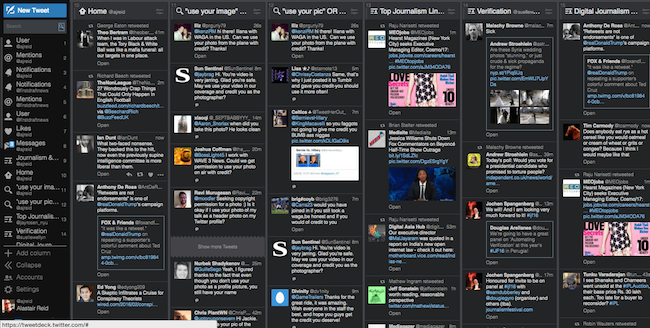
Lists won’t necessarily catch all the chatter though, so it’s worth setting up a couple of columns with customised searches. The best way to break down newsgathering on social media is into keyword and geolocation, and an obvious place to start is with the name of the place itself.
Street names and landmarks are also worth a shot, both with hashtags and without, but it’s important to remember how people speak when news breaks. Journalists think in keywords – “car crash on fifth avenue” – but someone who was at the scene is much more likely to tweet something along the lines of “OMG two cars just smashed into each other right in front of me”.
First-person pronouns (me, my, I), exclamations, swear words and keywords like “shooting” or earthquake”, for example, are all more likely to return tweets relevant to news.
Twitter’s EMEA lead for Moments Joanna Geary wrote a great guide for journalists using the platform in the build up to the UK election last year, and it can help to have a basic understanding of Boolean search for further tweaking.
But you can also use Tweetdeck to search for tweets geotagged to specific locations.
Right-click on a location in Google Maps and select “What’s here?” to see the lat/long co-ordinates, then enter these into Tweetdeck’s search bar – with “near:” and removing the space in the middle – to see tweets tagged to that location.
Precisely how far the search area around the specific point extends is unclear, so it helps to set the radius yourself using “within:” and a distance in miles.
“near:48.841294,2.253006 within:0.1mi”
You can then use the column options in Tweetdeck to filter your results to tweets with pictures and video or the number of retweets or likes a tweet has, if necessary.

When a gunman opened fire at the Umpqua Community College in October 2015, a geolocated search with “omg OR wtf AND shooting AND campus” would have found the following tweet:

How one of many students at the Umpqua Community College tweeted about an attack in October 2015
Combining these geolocation tricks in Tweetdeck with location or story keywords can help to find relevant tweets and contacts, but it may also be too noisy to be useful. Tweak the settings and combinations until you find something that works for you.
Geolocation
Talking of geolocation, Twitter isn’t the only social network that uses GPS to let users show where they are. Instagram, Flickr, the Russian network VKontakte and the Chinese Sina Weibo all have geotagging, among others.
Yomapic and Echosec are great free tools for searching by location, returning posts from Instagram and Vkontakte or Twitter and Flickr respectively. Choose a point on the map and either draw a search area or select a radius and the websites will return posts and images in that location.

Screenshot from Yomapic showing Instagram posts geotagged to the area around Covent Garden
There are much more powerful options available but they come with a price. Geofeedia and SAM Desk are both used by news organisations around the world for their features and add-ons including newsgathering, verification and curation across a range of social networks. But they are only really practical for those with big enough audiences (and wallets) to pay for it.
As the biggest social network in the world, Facebook has the potential to help journalists find stories and contacts like no other. But after severely limiting public access to its Graph Search – “a privacy nightmare” – the options for searching and newsgathering have been severely restricted.
Zuckerberg and co introduced Signal as a “discovery and curation tool for journalists” back in September 2015 but the dashboard has many limitations and is intensely US-focussed, despite the region comprising just 17 per cent of the global Facebook community.
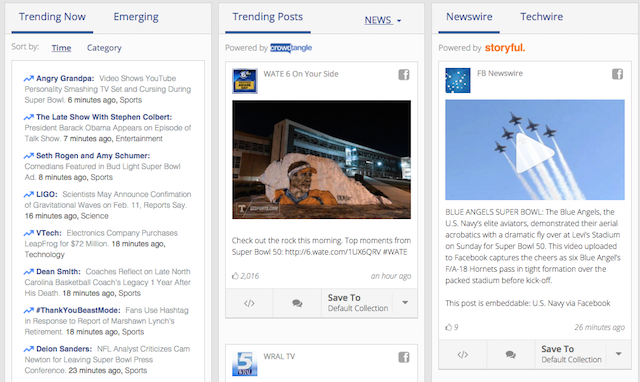
Screenshot from Facebook Signal
So what can we do?
Groups and interest lists are perhaps the best way to monitor communities and pages on Facebook for stories. Set up an interest list by clicking on ‘Interests’ in the Facebook side bar and then add Pages to the list around a relevant topic, like this one for media industry news. The result is a customised newsfeed, much like a Twitter list but for Facebook, displaying chronologically-listed posts from the select pages.
Monitoring official pages is only useful to an extent, however, so getting involved in groups and communities where people discuss their gripes and grievances can bring undisclosed stories to light. Search Facebook for a specific location or topic before selecting ‘groups’ from the results and browse through the groups available.
Now, Facebook may have shut down the public access for its Graph Search but that doesn’t mean it is no longer accessible. Michael Bazzell of the open-source intelligence website Intel Techniques has built a powerful and – frankly – terrifying search tool that works in a similar way to the old graph search.
Using tools like this can raise some serious ethical questions however, so don’t be surprised if a source is shocked you managed to find out information from their Facebook profile they thought was hidden.
Instagram eclipsed Twitter in terms of regular users back in September 2015, and is the social network of choice for many young, visually-minded members of the global digital community.
You can organise Instagram accounts into specific lists, like on Twitter or Facebook, with Iconosquare. Once signed up, go to ‘My Followings’ in the menu and organise accounts you follow into specific groups before viewing each group as a timeline in itself.
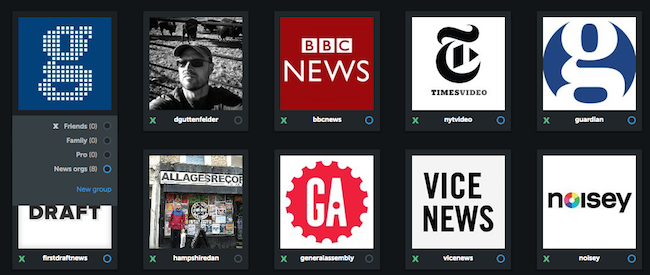
Organising Instagram accounts into groups with Iconosquare
You can search Instagram with Iconosquare, but Gramfeed is a more powerful platform for diving deep into Instagram, working like a dashboard to search for posts by hashtag, user account, keyword or location.
If This Then That
If This Then That (commonly referred to as IFTTT, or just IF) is a brilliantly simple and effective way to automate a lot of online habits or practices, like the robot butler you never knew you needed.
If following an event like a protest or political speech, IF can automatically build Twitter lists from everyone who tweets on a hashtag; it can save the tweets on a hashtag to a Google Doc; or even email you a daily digest of all tweets from a specific location. It can do most of that for Instagram as well, and can also combine with Dropbox, Facebook, Gmail, Flickr, Reddit and scores of other platforms or services.
Sign up and create ‘recipes’ between different services like the above, or browse the thousands of recipes already created by users to see what else is possible.
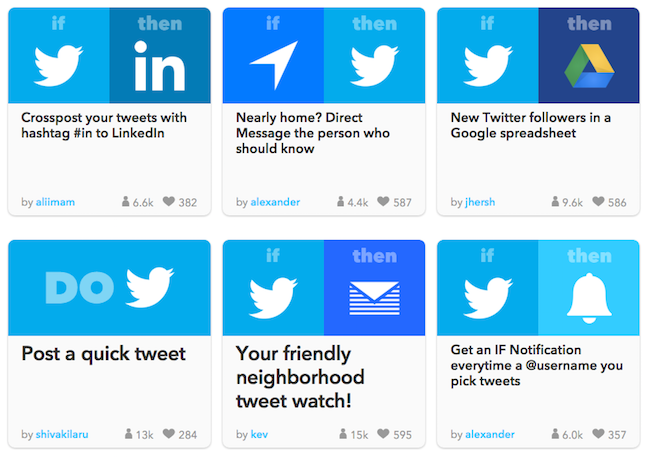
Some of the recipes available or Twitter at IFTTT.com
It is worth remembering, though, that IF will do exactly what you tell it to do without the added nuance of a human touch. Automation is great up to a point, but set the parameters too broadly and you may struggle to find a newsworthy signal in all that social noise.
Get the approach right
There has been a backlash from the public around how journalists approaching sources on social media in recent months. That tweet about the UCC shooting mentioned earlier received dozens of replies from reporters asking to contact, and hundreds more from other Twitter users furious with reporters who were just trying to do their job.
It is a sensitive and difficult issue that is still being refined. But first and foremost, don’t be an egg.
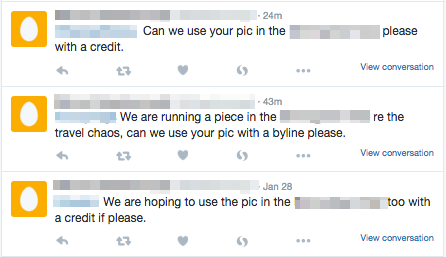
Screenshot from Twitter, with usernames blurred
This Twitter user is actually a fairly senior journalist at a local news paper in a major city, but there is nothing on their profile to signify this except regular requests to use pictures. Their approach is the digital equivalent of donning a balaclava and knocking on a stranger’s door to politely ask if they can borrow a cup of sugar.
So include a photo and a bit of personal information and if you are not a regular Twitter user, just share stories from your publication. You could even use IF to retweet your publication’s main account.
For the approach itself, most news organisations use some combination of being friendly; ascertaining whether the user captured the image; whether they can use and exhibiting genuine concern for what the witness has been through.
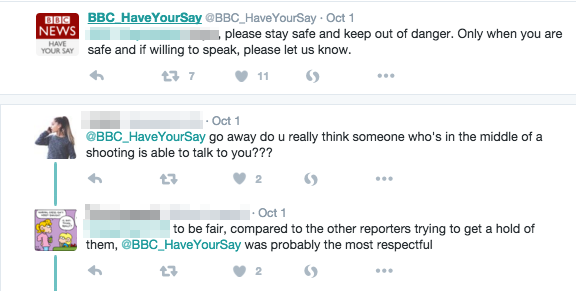
How the BBC reached out to a witness to the UCC shooting on Twitter
What many still leave out, however, is taking the conversation out of the public sphere. If you can get that person into a conversation in a direct message, email or on the phone you can find out so much more than you can in a quick note on a social network. And that rapport building is where the journalist’s skill lies.
Verify, verify, verify
There are two main reasons people share misinformation on social media: to gain followers by posting outrageous but believable claims, or to intentionally derail the news agenda. The journalist’s job is to report the truth, so it goes without saying that it is important to treat any claims seen online with the same healthy skepticism you would from a phone call or face-to-face conversation.
This doesn’t always happen though. In recent weeks, major news organisations published old footage of flight turbulence as if it were new and a staged video of a travel vlogger suffering a fish to the face during a storm, to name just a couple of examples.
There were some caveats questioning the truth of the latter in some publications, but the same doesn’t always happen in far more important stories. Both the San Bernardino shooting and Paris attacks of 2015 resulted in unverified falsehoods published or broadcast by news outlets.
Most news outlet questioned whether this video from a travel vlogger was true, but others claimed it was a “weather girl” in Wales. The direction the fish enters the shot compared to the direction of the waves and the fact it appear to be already gutted are just some red flags to its veracity.
We’ve got a whole section dedicated to verification reads and resources here at First Draft News, but the fundamentals are to establish the source, the date and location of an image. Find the original uploader of a picture or video, check out their social media history to see if there are inconsistencies with what they claim and try to speak to them.
You can print out our Visual Verification Guide to keep or your desk on in your pocket for quick reference as well.
Credit sources properly
You might be able to download an image with as much as a right-click, but the person who took it is still the copyright holder and should be credited accordingly. According to Storyful, the social newswire which has built a business on finding and licensing newsworthy images from social media to news outlets, the “vast majority” of online sources just want a credit.
Speaking to the source to establish how they want to be credited is vital and can lead to more information than a picture or video can provide, but journalists still have a responsibility to their sources.
An eyewitness to the Shoreham air disaster in the UK last August can be heard laughing in his video of cars and bodies burning in the streets. Having just witnessed a fighter jet smash into a busy road the man is obviously in shock, but some outlets published the audio and his account details, leading to “serious abuse” on Twitter.
Journalists should be more aware of the repercussions that going public like this can have, and can protect their sources from burning in the fire of publicity or, in some countries, put in very real danger.
Build a sense of community
Giving online sources the same respect as offline sources can not only ensure their safety and get you closer to the story, but also means they could be sources for other stories further down the line. Reporters spend a lot of time and effort cultivating their sources and developing their contact book with people they meet face to face, and the same can be true of people met online. It can be as simple as following up on stories, checking in to see if someone is ok following an accident or other trauma, or being active in online communities which may yield stories.
It is that community element that has always driven local reporting. Social media has turned journalism into a conversation rather than simply a broadcast medium, and although that has more often been true in the past among local media compared to the national press, combining traditional skills with new digital services can make the difference between just getting the story and making journalism a positive force in the community.
Check out more First Draft reads and resources on social newsgathering



